An Analysis of Time-Driven Activity-Based Costing for Wesfarmers
VerifiedAdded on 2020/05/16
|11
|2484
|76
Report
AI Summary
This report delves into Time-Driven Activity-Based Costing (TDABC) as a cost management technique, contrasting it with traditional and original Activity-Based Costing (ABC) methods. It outlines the core principles of TDABC, emphasizing its simplicity and efficiency in managing costs and resource capacity within organizations. The report examines the advantages of TDABC, such as reduced data requirements and easier updates compared to the original ABC model, making it suitable for large-scale organizations. It also investigates the potential of TDABC for a company like Wesfarmers, a major Australian conglomerate, evaluating its reliability in enhancing cost management and creating value for shareholders. The report concludes by highlighting TDABC's significance in the current business environment, emphasizing its role in improving cost systems and addressing cost-related issues. The report also looks at the features of TDABC like handling and updating the model is very easy as it only considers the two factors of any process. This model easily reflects the changes related to the process, orders, and resources.
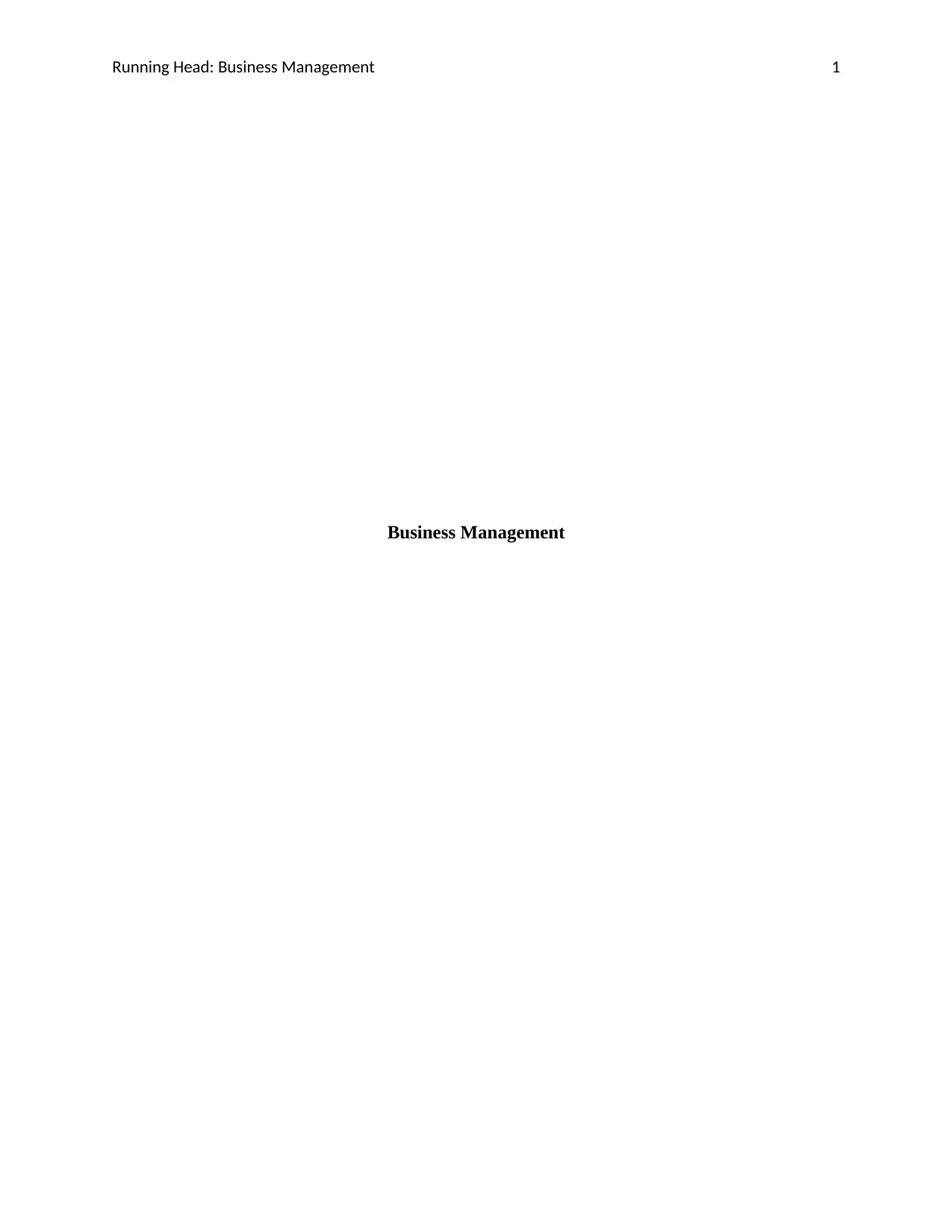
Running Head: Business Management 1
Business Management
Business Management
Paraphrase This Document
Need a fresh take? Get an instant paraphrase of this document with our AI Paraphraser
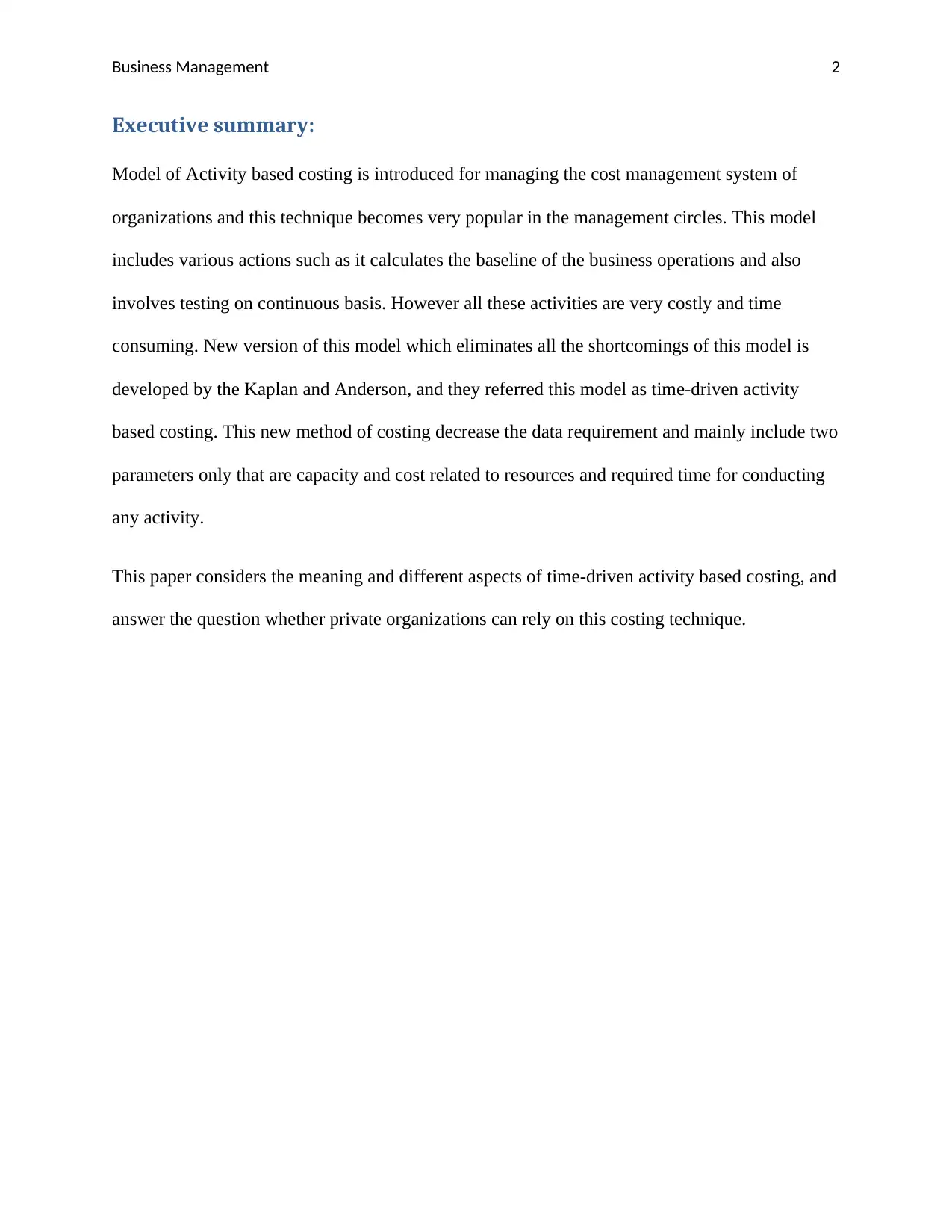
Business Management 2
Executive summary:
Model of Activity based costing is introduced for managing the cost management system of
organizations and this technique becomes very popular in the management circles. This model
includes various actions such as it calculates the baseline of the business operations and also
involves testing on continuous basis. However all these activities are very costly and time
consuming. New version of this model which eliminates all the shortcomings of this model is
developed by the Kaplan and Anderson, and they referred this model as time-driven activity
based costing. This new method of costing decrease the data requirement and mainly include two
parameters only that are capacity and cost related to resources and required time for conducting
any activity.
This paper considers the meaning and different aspects of time-driven activity based costing, and
answer the question whether private organizations can rely on this costing technique.
Executive summary:
Model of Activity based costing is introduced for managing the cost management system of
organizations and this technique becomes very popular in the management circles. This model
includes various actions such as it calculates the baseline of the business operations and also
involves testing on continuous basis. However all these activities are very costly and time
consuming. New version of this model which eliminates all the shortcomings of this model is
developed by the Kaplan and Anderson, and they referred this model as time-driven activity
based costing. This new method of costing decrease the data requirement and mainly include two
parameters only that are capacity and cost related to resources and required time for conducting
any activity.
This paper considers the meaning and different aspects of time-driven activity based costing, and
answer the question whether private organizations can rely on this costing technique.
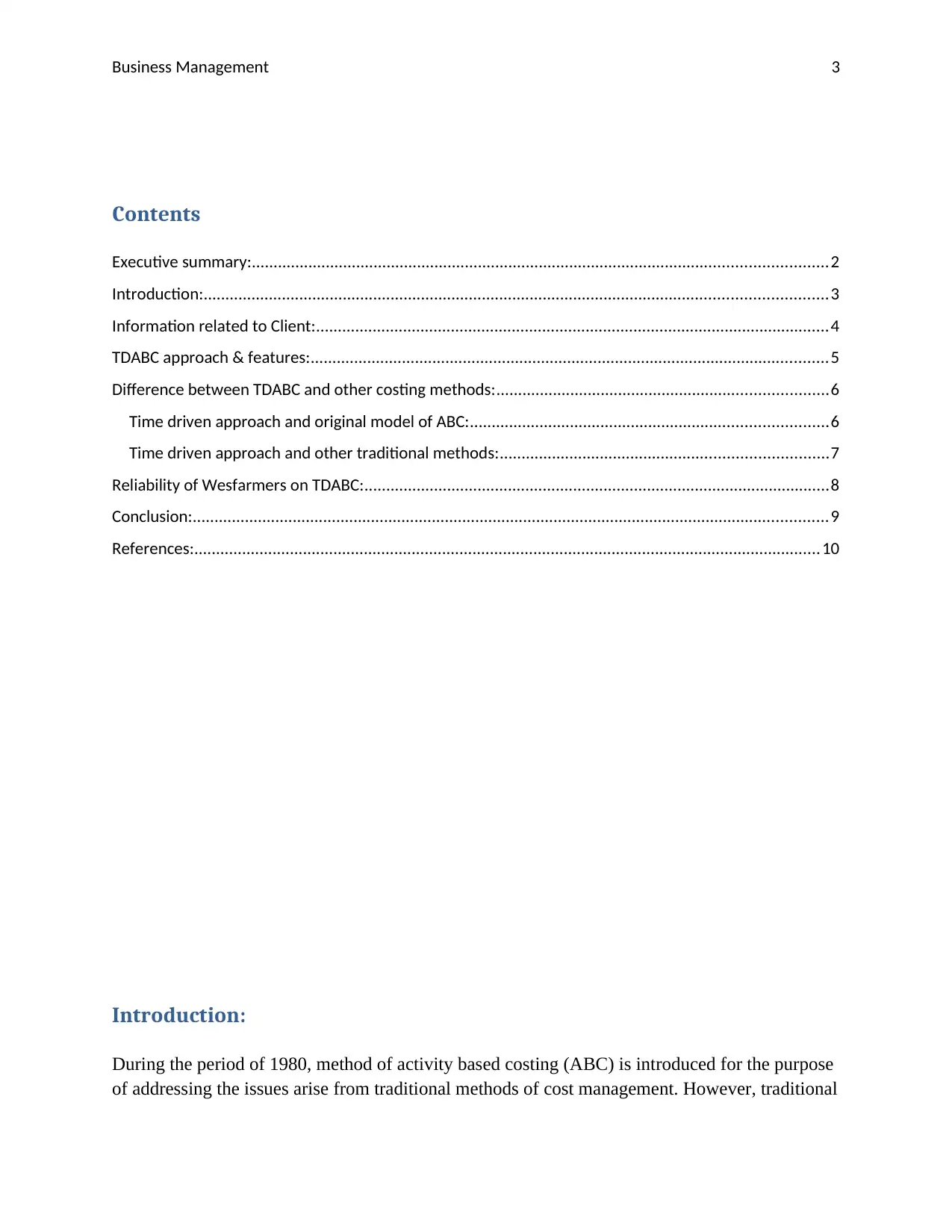
Business Management 3
Contents
Executive summary:....................................................................................................................................2
Introduction:...............................................................................................................................................3
Information related to Client:......................................................................................................................4
TDABC approach & features:.......................................................................................................................5
Difference between TDABC and other costing methods:............................................................................6
Time driven approach and original model of ABC:..................................................................................6
Time driven approach and other traditional methods:...........................................................................7
Reliability of Wesfarmers on TDABC:...........................................................................................................8
Conclusion:..................................................................................................................................................9
References:................................................................................................................................................10
Introduction:
During the period of 1980, method of activity based costing (ABC) is introduced for the purpose
of addressing the issues arise from traditional methods of cost management. However, traditional
Contents
Executive summary:....................................................................................................................................2
Introduction:...............................................................................................................................................3
Information related to Client:......................................................................................................................4
TDABC approach & features:.......................................................................................................................5
Difference between TDABC and other costing methods:............................................................................6
Time driven approach and original model of ABC:..................................................................................6
Time driven approach and other traditional methods:...........................................................................7
Reliability of Wesfarmers on TDABC:...........................................................................................................8
Conclusion:..................................................................................................................................................9
References:................................................................................................................................................10
Introduction:
During the period of 1980, method of activity based costing (ABC) is introduced for the purpose
of addressing the issues arise from traditional methods of cost management. However, traditional
⊘ This is a preview!⊘
Do you want full access?
Subscribe today to unlock all pages.

Trusted by 1+ million students worldwide
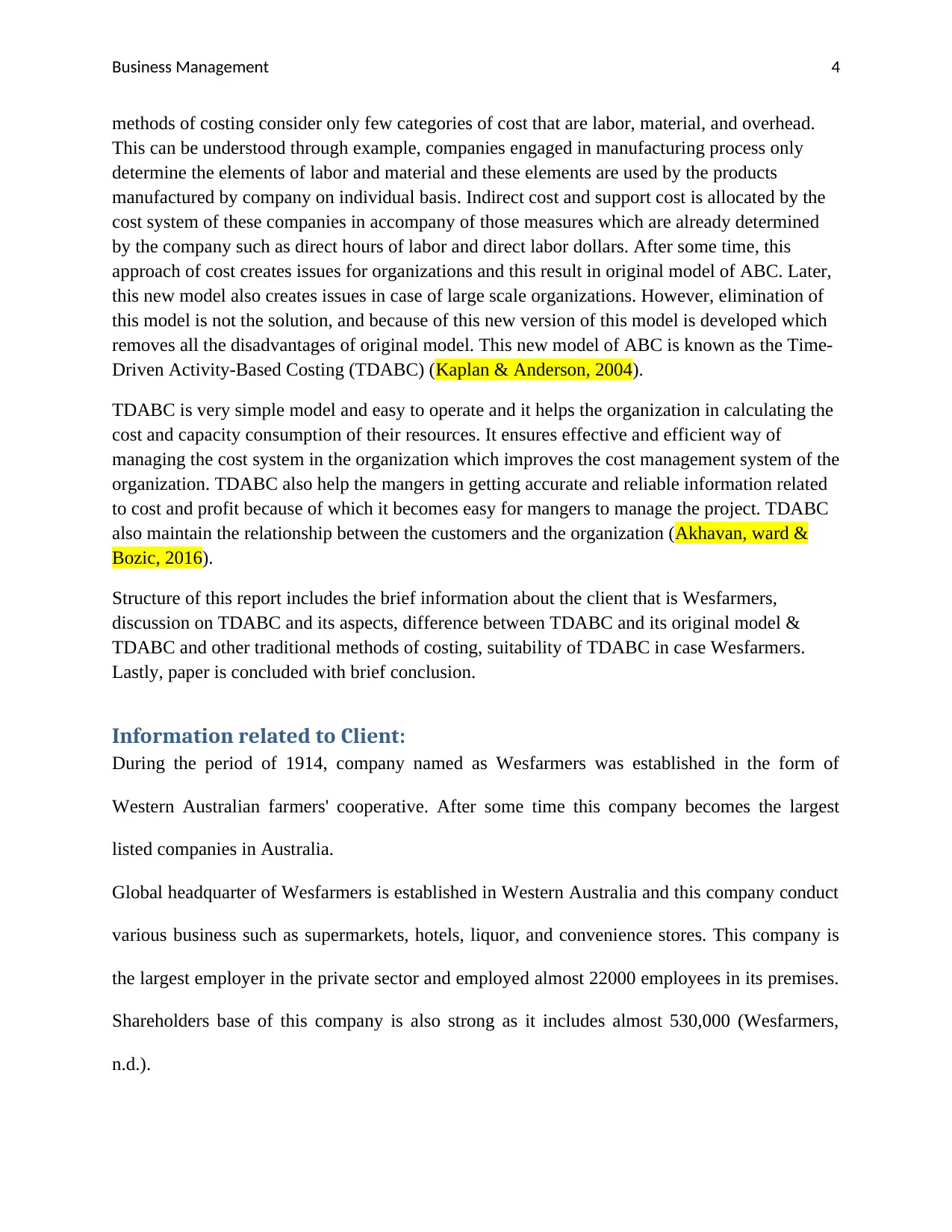
Business Management 4
methods of costing consider only few categories of cost that are labor, material, and overhead.
This can be understood through example, companies engaged in manufacturing process only
determine the elements of labor and material and these elements are used by the products
manufactured by company on individual basis. Indirect cost and support cost is allocated by the
cost system of these companies in accompany of those measures which are already determined
by the company such as direct hours of labor and direct labor dollars. After some time, this
approach of cost creates issues for organizations and this result in original model of ABC. Later,
this new model also creates issues in case of large scale organizations. However, elimination of
this model is not the solution, and because of this new version of this model is developed which
removes all the disadvantages of original model. This new model of ABC is known as the Time-
Driven Activity-Based Costing (TDABC) (Kaplan & Anderson, 2004).
TDABC is very simple model and easy to operate and it helps the organization in calculating the
cost and capacity consumption of their resources. It ensures effective and efficient way of
managing the cost system in the organization which improves the cost management system of the
organization. TDABC also help the mangers in getting accurate and reliable information related
to cost and profit because of which it becomes easy for mangers to manage the project. TDABC
also maintain the relationship between the customers and the organization (Akhavan, ward &
Bozic, 2016).
Structure of this report includes the brief information about the client that is Wesfarmers,
discussion on TDABC and its aspects, difference between TDABC and its original model &
TDABC and other traditional methods of costing, suitability of TDABC in case Wesfarmers.
Lastly, paper is concluded with brief conclusion.
Information related to Client:
During the period of 1914, company named as Wesfarmers was established in the form of
Western Australian farmers' cooperative. After some time this company becomes the largest
listed companies in Australia.
Global headquarter of Wesfarmers is established in Western Australia and this company conduct
various business such as supermarkets, hotels, liquor, and convenience stores. This company is
the largest employer in the private sector and employed almost 22000 employees in its premises.
Shareholders base of this company is also strong as it includes almost 530,000 (Wesfarmers,
n.d.).
methods of costing consider only few categories of cost that are labor, material, and overhead.
This can be understood through example, companies engaged in manufacturing process only
determine the elements of labor and material and these elements are used by the products
manufactured by company on individual basis. Indirect cost and support cost is allocated by the
cost system of these companies in accompany of those measures which are already determined
by the company such as direct hours of labor and direct labor dollars. After some time, this
approach of cost creates issues for organizations and this result in original model of ABC. Later,
this new model also creates issues in case of large scale organizations. However, elimination of
this model is not the solution, and because of this new version of this model is developed which
removes all the disadvantages of original model. This new model of ABC is known as the Time-
Driven Activity-Based Costing (TDABC) (Kaplan & Anderson, 2004).
TDABC is very simple model and easy to operate and it helps the organization in calculating the
cost and capacity consumption of their resources. It ensures effective and efficient way of
managing the cost system in the organization which improves the cost management system of the
organization. TDABC also help the mangers in getting accurate and reliable information related
to cost and profit because of which it becomes easy for mangers to manage the project. TDABC
also maintain the relationship between the customers and the organization (Akhavan, ward &
Bozic, 2016).
Structure of this report includes the brief information about the client that is Wesfarmers,
discussion on TDABC and its aspects, difference between TDABC and its original model &
TDABC and other traditional methods of costing, suitability of TDABC in case Wesfarmers.
Lastly, paper is concluded with brief conclusion.
Information related to Client:
During the period of 1914, company named as Wesfarmers was established in the form of
Western Australian farmers' cooperative. After some time this company becomes the largest
listed companies in Australia.
Global headquarter of Wesfarmers is established in Western Australia and this company conduct
various business such as supermarkets, hotels, liquor, and convenience stores. This company is
the largest employer in the private sector and employed almost 22000 employees in its premises.
Shareholders base of this company is also strong as it includes almost 530,000 (Wesfarmers,
n.d.).
Paraphrase This Document
Need a fresh take? Get an instant paraphrase of this document with our AI Paraphraser
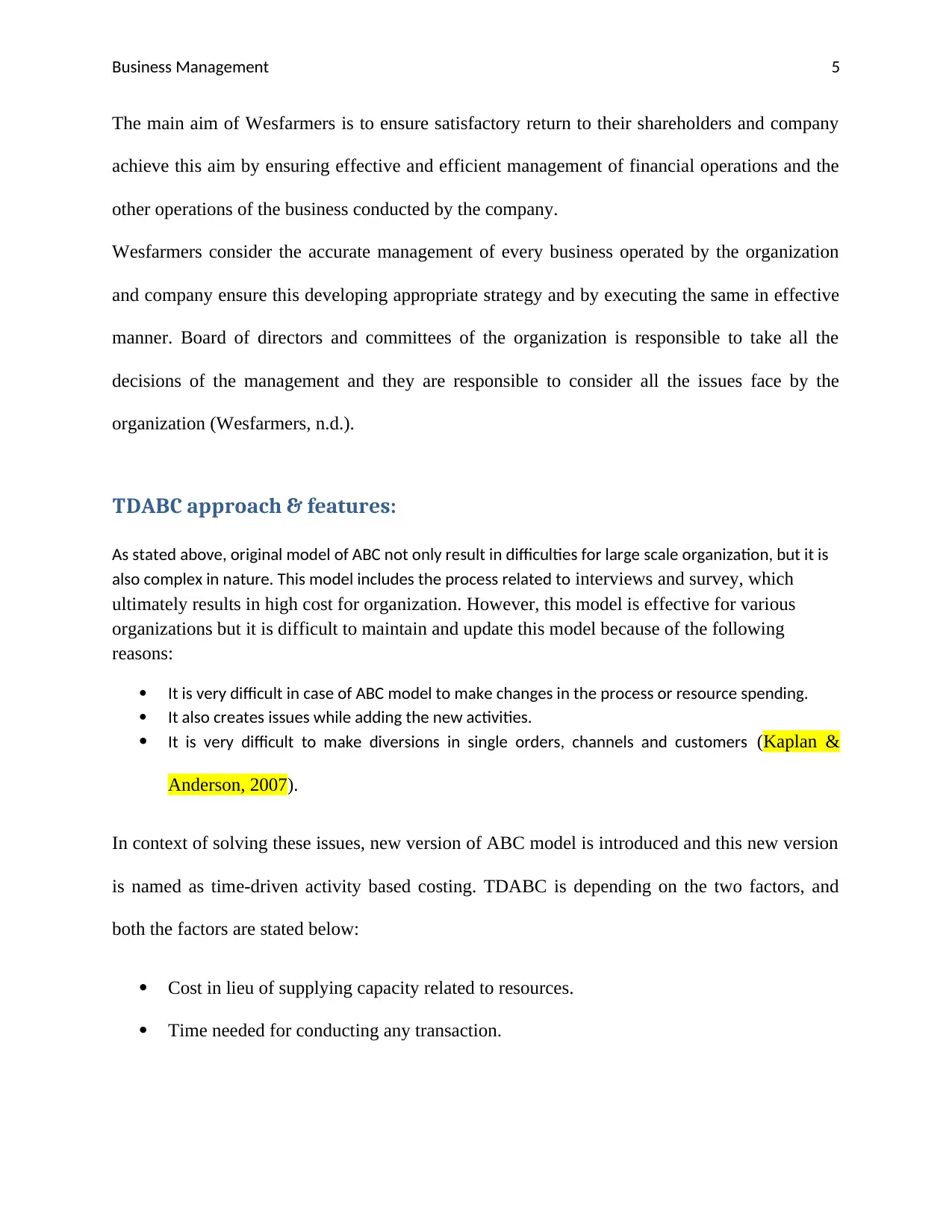
Business Management 5
The main aim of Wesfarmers is to ensure satisfactory return to their shareholders and company
achieve this aim by ensuring effective and efficient management of financial operations and the
other operations of the business conducted by the company.
Wesfarmers consider the accurate management of every business operated by the organization
and company ensure this developing appropriate strategy and by executing the same in effective
manner. Board of directors and committees of the organization is responsible to take all the
decisions of the management and they are responsible to consider all the issues face by the
organization (Wesfarmers, n.d.).
TDABC approach & features:
As stated above, original model of ABC not only result in difficulties for large scale organization, but it is
also complex in nature. This model includes the process related to interviews and survey, which
ultimately results in high cost for organization. However, this model is effective for various
organizations but it is difficult to maintain and update this model because of the following
reasons:
It is very difficult in case of ABC model to make changes in the process or resource spending.
It also creates issues while adding the new activities.
It is very difficult to make diversions in single orders, channels and customers (Kaplan &
Anderson, 2007).
In context of solving these issues, new version of ABC model is introduced and this new version
is named as time-driven activity based costing. TDABC is depending on the two factors, and
both the factors are stated below:
Cost in lieu of supplying capacity related to resources.
Time needed for conducting any transaction.
The main aim of Wesfarmers is to ensure satisfactory return to their shareholders and company
achieve this aim by ensuring effective and efficient management of financial operations and the
other operations of the business conducted by the company.
Wesfarmers consider the accurate management of every business operated by the organization
and company ensure this developing appropriate strategy and by executing the same in effective
manner. Board of directors and committees of the organization is responsible to take all the
decisions of the management and they are responsible to consider all the issues face by the
organization (Wesfarmers, n.d.).
TDABC approach & features:
As stated above, original model of ABC not only result in difficulties for large scale organization, but it is
also complex in nature. This model includes the process related to interviews and survey, which
ultimately results in high cost for organization. However, this model is effective for various
organizations but it is difficult to maintain and update this model because of the following
reasons:
It is very difficult in case of ABC model to make changes in the process or resource spending.
It also creates issues while adding the new activities.
It is very difficult to make diversions in single orders, channels and customers (Kaplan &
Anderson, 2007).
In context of solving these issues, new version of ABC model is introduced and this new version
is named as time-driven activity based costing. TDABC is depending on the two factors, and
both the factors are stated below:
Cost in lieu of supplying capacity related to resources.
Time needed for conducting any transaction.
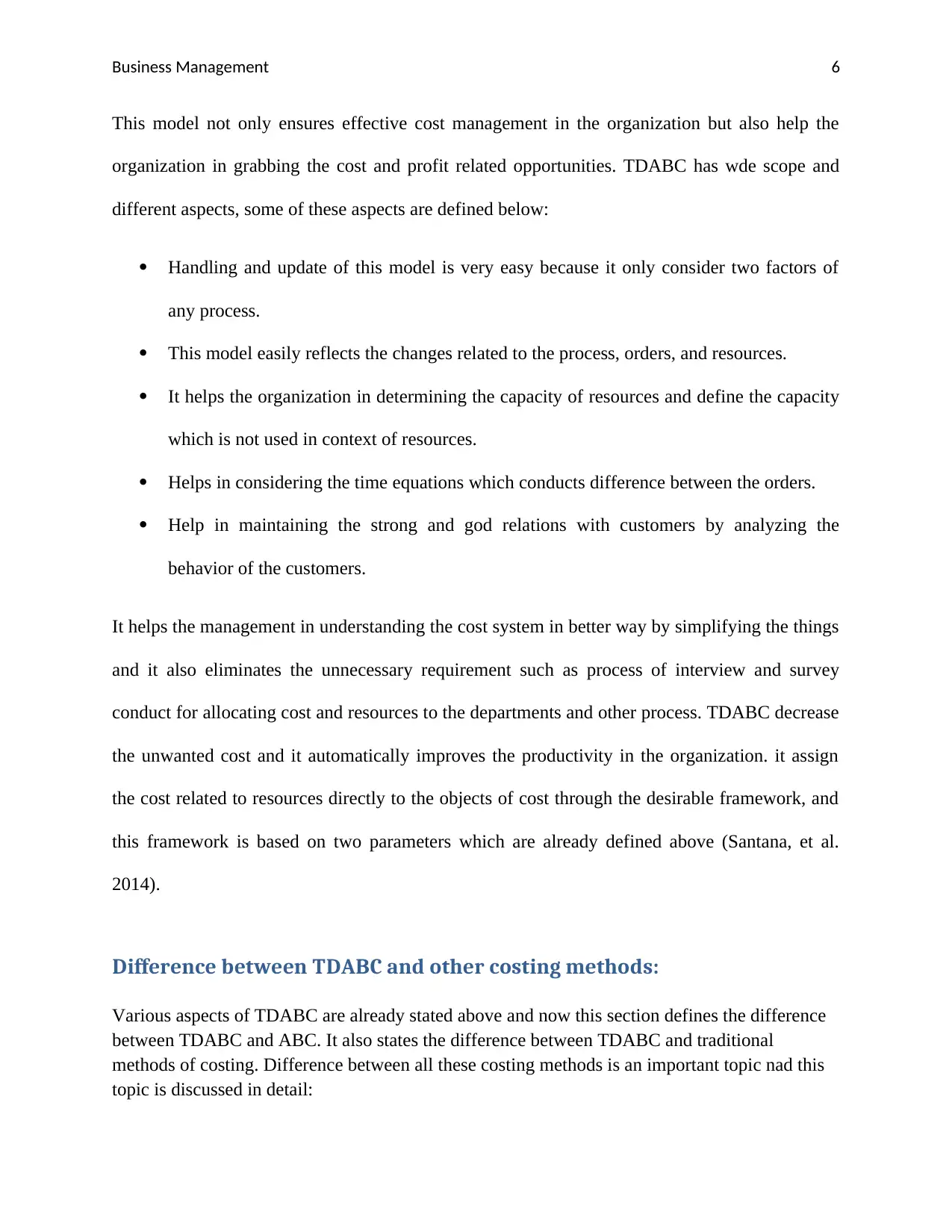
Business Management 6
This model not only ensures effective cost management in the organization but also help the
organization in grabbing the cost and profit related opportunities. TDABC has wde scope and
different aspects, some of these aspects are defined below:
Handling and update of this model is very easy because it only consider two factors of
any process.
This model easily reflects the changes related to the process, orders, and resources.
It helps the organization in determining the capacity of resources and define the capacity
which is not used in context of resources.
Helps in considering the time equations which conducts difference between the orders.
Help in maintaining the strong and god relations with customers by analyzing the
behavior of the customers.
It helps the management in understanding the cost system in better way by simplifying the things
and it also eliminates the unnecessary requirement such as process of interview and survey
conduct for allocating cost and resources to the departments and other process. TDABC decrease
the unwanted cost and it automatically improves the productivity in the organization. it assign
the cost related to resources directly to the objects of cost through the desirable framework, and
this framework is based on two parameters which are already defined above (Santana, et al.
2014).
Difference between TDABC and other costing methods:
Various aspects of TDABC are already stated above and now this section defines the difference
between TDABC and ABC. It also states the difference between TDABC and traditional
methods of costing. Difference between all these costing methods is an important topic nad this
topic is discussed in detail:
This model not only ensures effective cost management in the organization but also help the
organization in grabbing the cost and profit related opportunities. TDABC has wde scope and
different aspects, some of these aspects are defined below:
Handling and update of this model is very easy because it only consider two factors of
any process.
This model easily reflects the changes related to the process, orders, and resources.
It helps the organization in determining the capacity of resources and define the capacity
which is not used in context of resources.
Helps in considering the time equations which conducts difference between the orders.
Help in maintaining the strong and god relations with customers by analyzing the
behavior of the customers.
It helps the management in understanding the cost system in better way by simplifying the things
and it also eliminates the unnecessary requirement such as process of interview and survey
conduct for allocating cost and resources to the departments and other process. TDABC decrease
the unwanted cost and it automatically improves the productivity in the organization. it assign
the cost related to resources directly to the objects of cost through the desirable framework, and
this framework is based on two parameters which are already defined above (Santana, et al.
2014).
Difference between TDABC and other costing methods:
Various aspects of TDABC are already stated above and now this section defines the difference
between TDABC and ABC. It also states the difference between TDABC and traditional
methods of costing. Difference between all these costing methods is an important topic nad this
topic is discussed in detail:
⊘ This is a preview!⊘
Do you want full access?
Subscribe today to unlock all pages.

Trusted by 1+ million students worldwide
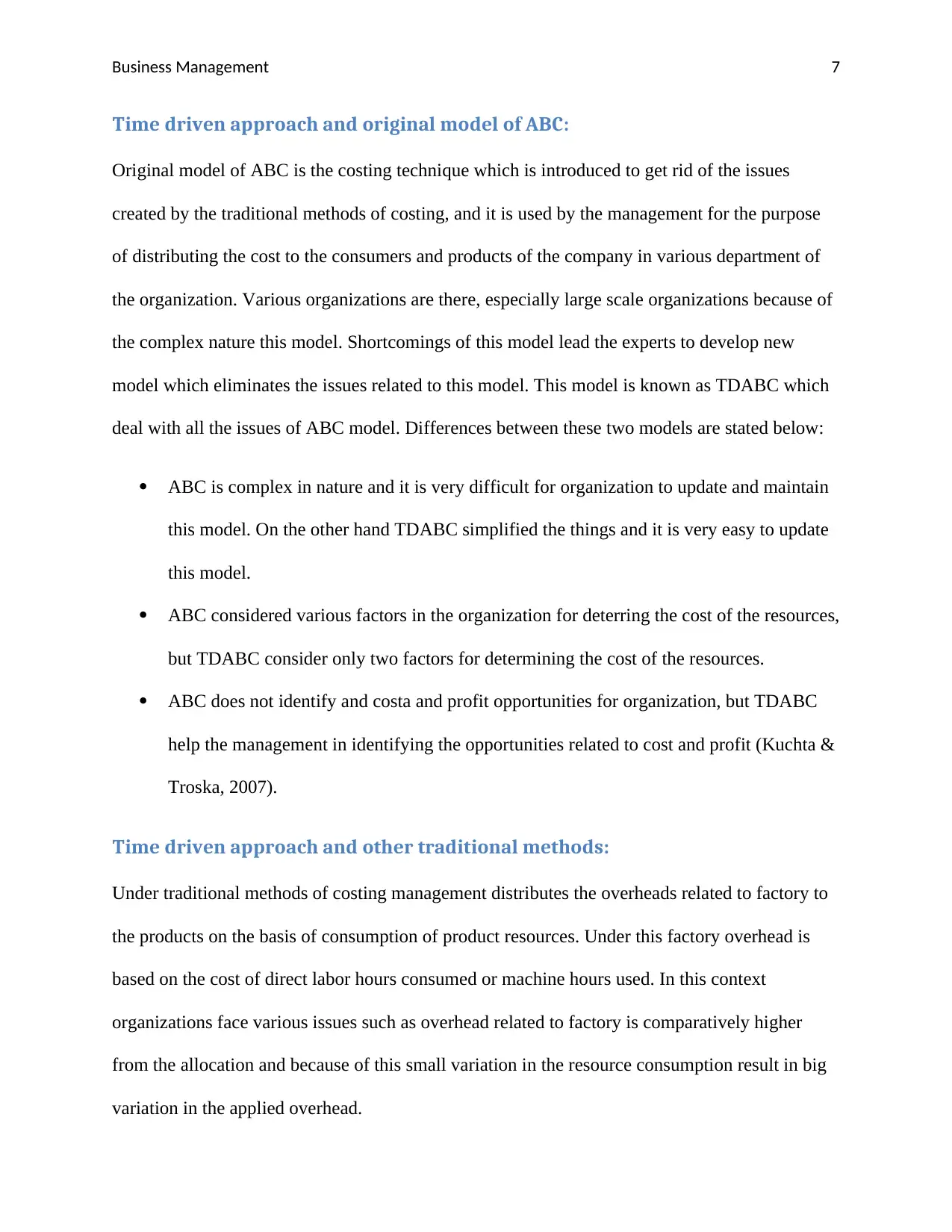
Business Management 7
Time driven approach and original model of ABC:
Original model of ABC is the costing technique which is introduced to get rid of the issues
created by the traditional methods of costing, and it is used by the management for the purpose
of distributing the cost to the consumers and products of the company in various department of
the organization. Various organizations are there, especially large scale organizations because of
the complex nature this model. Shortcomings of this model lead the experts to develop new
model which eliminates the issues related to this model. This model is known as TDABC which
deal with all the issues of ABC model. Differences between these two models are stated below:
ABC is complex in nature and it is very difficult for organization to update and maintain
this model. On the other hand TDABC simplified the things and it is very easy to update
this model.
ABC considered various factors in the organization for deterring the cost of the resources,
but TDABC consider only two factors for determining the cost of the resources.
ABC does not identify and costa and profit opportunities for organization, but TDABC
help the management in identifying the opportunities related to cost and profit (Kuchta &
Troska, 2007).
Time driven approach and other traditional methods:
Under traditional methods of costing management distributes the overheads related to factory to
the products on the basis of consumption of product resources. Under this factory overhead is
based on the cost of direct labor hours consumed or machine hours used. In this context
organizations face various issues such as overhead related to factory is comparatively higher
from the allocation and because of this small variation in the resource consumption result in big
variation in the applied overhead.
Time driven approach and original model of ABC:
Original model of ABC is the costing technique which is introduced to get rid of the issues
created by the traditional methods of costing, and it is used by the management for the purpose
of distributing the cost to the consumers and products of the company in various department of
the organization. Various organizations are there, especially large scale organizations because of
the complex nature this model. Shortcomings of this model lead the experts to develop new
model which eliminates the issues related to this model. This model is known as TDABC which
deal with all the issues of ABC model. Differences between these two models are stated below:
ABC is complex in nature and it is very difficult for organization to update and maintain
this model. On the other hand TDABC simplified the things and it is very easy to update
this model.
ABC considered various factors in the organization for deterring the cost of the resources,
but TDABC consider only two factors for determining the cost of the resources.
ABC does not identify and costa and profit opportunities for organization, but TDABC
help the management in identifying the opportunities related to cost and profit (Kuchta &
Troska, 2007).
Time driven approach and other traditional methods:
Under traditional methods of costing management distributes the overheads related to factory to
the products on the basis of consumption of product resources. Under this factory overhead is
based on the cost of direct labor hours consumed or machine hours used. In this context
organizations face various issues such as overhead related to factory is comparatively higher
from the allocation and because of this small variation in the resource consumption result in big
variation in the applied overhead.
Paraphrase This Document
Need a fresh take? Get an instant paraphrase of this document with our AI Paraphraser
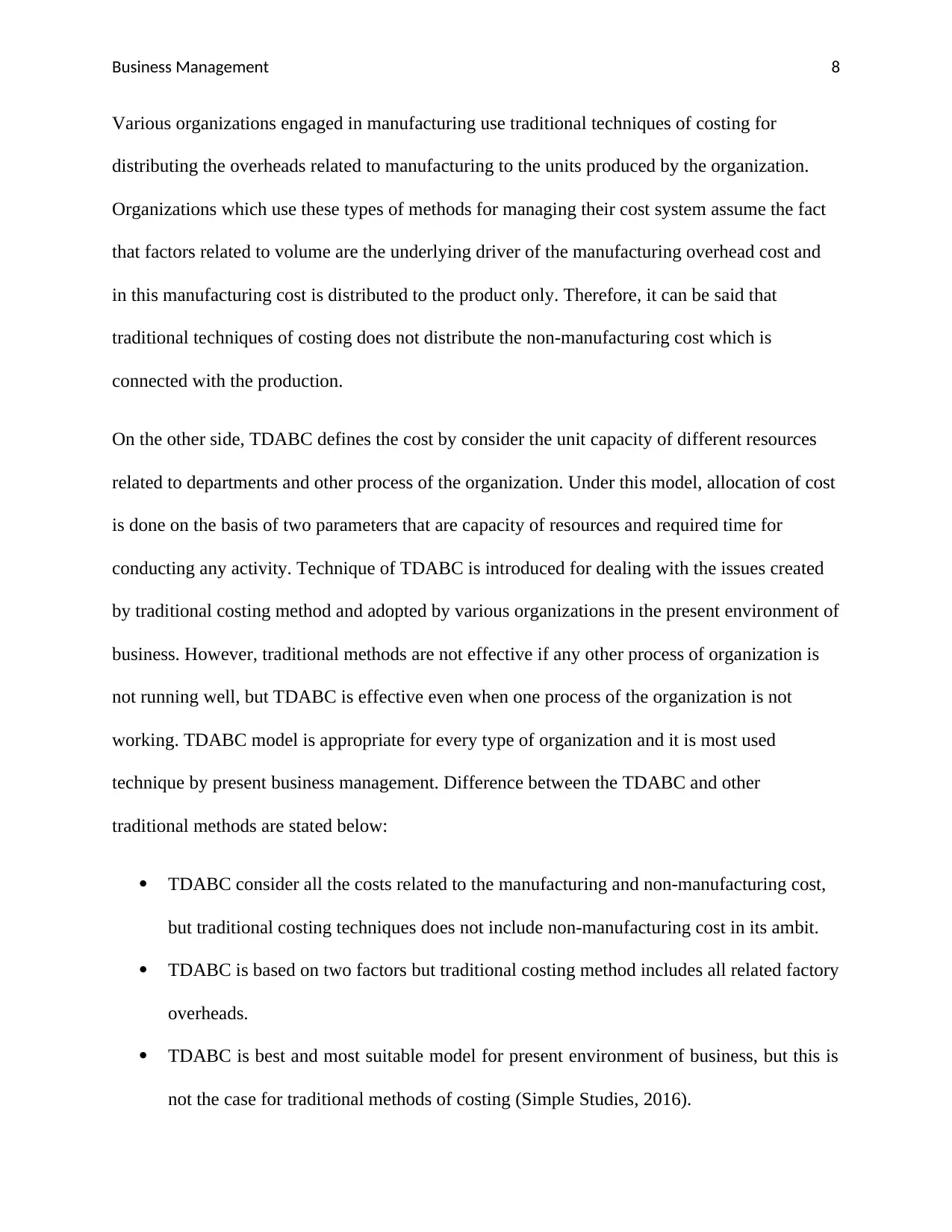
Business Management 8
Various organizations engaged in manufacturing use traditional techniques of costing for
distributing the overheads related to manufacturing to the units produced by the organization.
Organizations which use these types of methods for managing their cost system assume the fact
that factors related to volume are the underlying driver of the manufacturing overhead cost and
in this manufacturing cost is distributed to the product only. Therefore, it can be said that
traditional techniques of costing does not distribute the non-manufacturing cost which is
connected with the production.
On the other side, TDABC defines the cost by consider the unit capacity of different resources
related to departments and other process of the organization. Under this model, allocation of cost
is done on the basis of two parameters that are capacity of resources and required time for
conducting any activity. Technique of TDABC is introduced for dealing with the issues created
by traditional costing method and adopted by various organizations in the present environment of
business. However, traditional methods are not effective if any other process of organization is
not running well, but TDABC is effective even when one process of the organization is not
working. TDABC model is appropriate for every type of organization and it is most used
technique by present business management. Difference between the TDABC and other
traditional methods are stated below:
TDABC consider all the costs related to the manufacturing and non-manufacturing cost,
but traditional costing techniques does not include non-manufacturing cost in its ambit.
TDABC is based on two factors but traditional costing method includes all related factory
overheads.
TDABC is best and most suitable model for present environment of business, but this is
not the case for traditional methods of costing (Simple Studies, 2016).
Various organizations engaged in manufacturing use traditional techniques of costing for
distributing the overheads related to manufacturing to the units produced by the organization.
Organizations which use these types of methods for managing their cost system assume the fact
that factors related to volume are the underlying driver of the manufacturing overhead cost and
in this manufacturing cost is distributed to the product only. Therefore, it can be said that
traditional techniques of costing does not distribute the non-manufacturing cost which is
connected with the production.
On the other side, TDABC defines the cost by consider the unit capacity of different resources
related to departments and other process of the organization. Under this model, allocation of cost
is done on the basis of two parameters that are capacity of resources and required time for
conducting any activity. Technique of TDABC is introduced for dealing with the issues created
by traditional costing method and adopted by various organizations in the present environment of
business. However, traditional methods are not effective if any other process of organization is
not running well, but TDABC is effective even when one process of the organization is not
working. TDABC model is appropriate for every type of organization and it is most used
technique by present business management. Difference between the TDABC and other
traditional methods are stated below:
TDABC consider all the costs related to the manufacturing and non-manufacturing cost,
but traditional costing techniques does not include non-manufacturing cost in its ambit.
TDABC is based on two factors but traditional costing method includes all related factory
overheads.
TDABC is best and most suitable model for present environment of business, but this is
not the case for traditional methods of costing (Simple Studies, 2016).
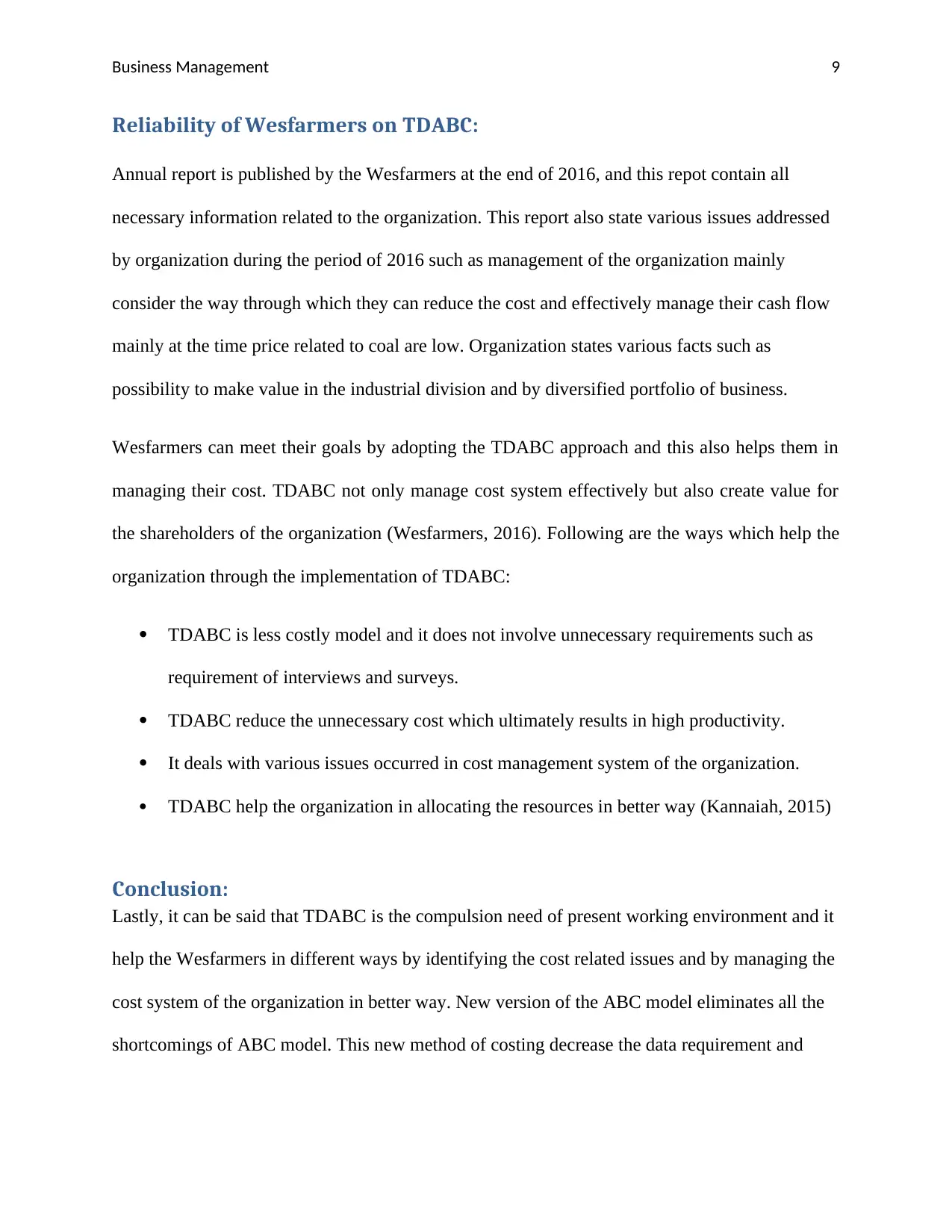
Business Management 9
Reliability of Wesfarmers on TDABC:
Annual report is published by the Wesfarmers at the end of 2016, and this repot contain all
necessary information related to the organization. This report also state various issues addressed
by organization during the period of 2016 such as management of the organization mainly
consider the way through which they can reduce the cost and effectively manage their cash flow
mainly at the time price related to coal are low. Organization states various facts such as
possibility to make value in the industrial division and by diversified portfolio of business.
Wesfarmers can meet their goals by adopting the TDABC approach and this also helps them in
managing their cost. TDABC not only manage cost system effectively but also create value for
the shareholders of the organization (Wesfarmers, 2016). Following are the ways which help the
organization through the implementation of TDABC:
TDABC is less costly model and it does not involve unnecessary requirements such as
requirement of interviews and surveys.
TDABC reduce the unnecessary cost which ultimately results in high productivity.
It deals with various issues occurred in cost management system of the organization.
TDABC help the organization in allocating the resources in better way (Kannaiah, 2015)
Conclusion:
Lastly, it can be said that TDABC is the compulsion need of present working environment and it
help the Wesfarmers in different ways by identifying the cost related issues and by managing the
cost system of the organization in better way. New version of the ABC model eliminates all the
shortcomings of ABC model. This new method of costing decrease the data requirement and
Reliability of Wesfarmers on TDABC:
Annual report is published by the Wesfarmers at the end of 2016, and this repot contain all
necessary information related to the organization. This report also state various issues addressed
by organization during the period of 2016 such as management of the organization mainly
consider the way through which they can reduce the cost and effectively manage their cash flow
mainly at the time price related to coal are low. Organization states various facts such as
possibility to make value in the industrial division and by diversified portfolio of business.
Wesfarmers can meet their goals by adopting the TDABC approach and this also helps them in
managing their cost. TDABC not only manage cost system effectively but also create value for
the shareholders of the organization (Wesfarmers, 2016). Following are the ways which help the
organization through the implementation of TDABC:
TDABC is less costly model and it does not involve unnecessary requirements such as
requirement of interviews and surveys.
TDABC reduce the unnecessary cost which ultimately results in high productivity.
It deals with various issues occurred in cost management system of the organization.
TDABC help the organization in allocating the resources in better way (Kannaiah, 2015)
Conclusion:
Lastly, it can be said that TDABC is the compulsion need of present working environment and it
help the Wesfarmers in different ways by identifying the cost related issues and by managing the
cost system of the organization in better way. New version of the ABC model eliminates all the
shortcomings of ABC model. This new method of costing decrease the data requirement and
⊘ This is a preview!⊘
Do you want full access?
Subscribe today to unlock all pages.

Trusted by 1+ million students worldwide
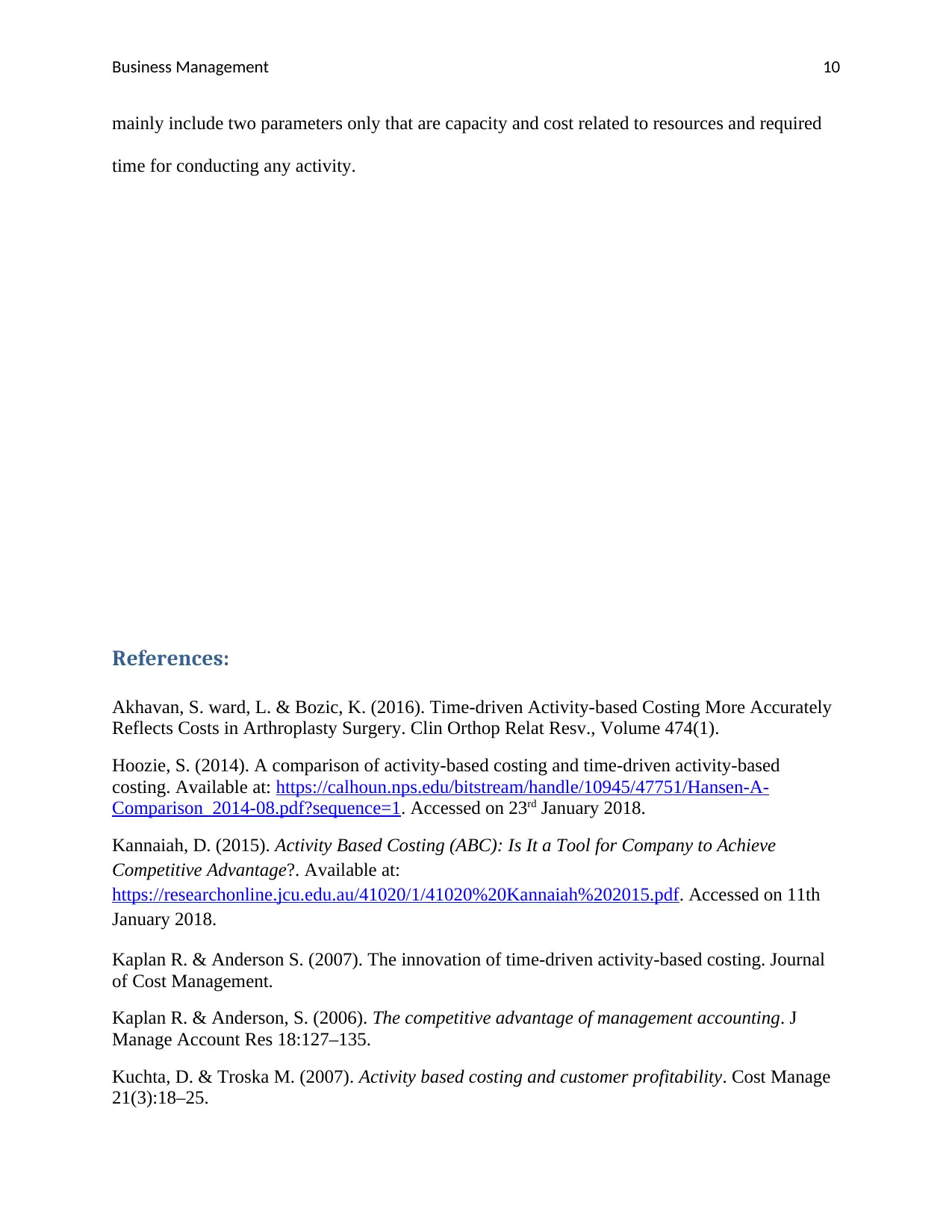
Business Management 10
mainly include two parameters only that are capacity and cost related to resources and required
time for conducting any activity.
References:
Akhavan, S. ward, L. & Bozic, K. (2016). Time-driven Activity-based Costing More Accurately
Reflects Costs in Arthroplasty Surgery. Clin Orthop Relat Resv., Volume 474(1).
Hoozie, S. (2014). A comparison of activity-based costing and time-driven activity-based
costing. Available at: https://calhoun.nps.edu/bitstream/handle/10945/47751/Hansen-A-
Comparison_2014-08.pdf?sequence=1. Accessed on 23rd January 2018.
Kannaiah, D. (2015). Activity Based Costing (ABC): Is It a Tool for Company to Achieve
Competitive Advantage?. Available at:
https://researchonline.jcu.edu.au/41020/1/41020%20Kannaiah%202015.pdf. Accessed on 11th
January 2018.
Kaplan R. & Anderson S. (2007). The innovation of time-driven activity-based costing. Journal
of Cost Management.
Kaplan R. & Anderson, S. (2006). The competitive advantage of management accounting. J
Manage Account Res 18:127–135.
Kuchta, D. & Troska M. (2007). Activity based costing and customer profitability. Cost Manage
21(3):18–25.
mainly include two parameters only that are capacity and cost related to resources and required
time for conducting any activity.
References:
Akhavan, S. ward, L. & Bozic, K. (2016). Time-driven Activity-based Costing More Accurately
Reflects Costs in Arthroplasty Surgery. Clin Orthop Relat Resv., Volume 474(1).
Hoozie, S. (2014). A comparison of activity-based costing and time-driven activity-based
costing. Available at: https://calhoun.nps.edu/bitstream/handle/10945/47751/Hansen-A-
Comparison_2014-08.pdf?sequence=1. Accessed on 23rd January 2018.
Kannaiah, D. (2015). Activity Based Costing (ABC): Is It a Tool for Company to Achieve
Competitive Advantage?. Available at:
https://researchonline.jcu.edu.au/41020/1/41020%20Kannaiah%202015.pdf. Accessed on 11th
January 2018.
Kaplan R. & Anderson S. (2007). The innovation of time-driven activity-based costing. Journal
of Cost Management.
Kaplan R. & Anderson, S. (2006). The competitive advantage of management accounting. J
Manage Account Res 18:127–135.
Kuchta, D. & Troska M. (2007). Activity based costing and customer profitability. Cost Manage
21(3):18–25.
Paraphrase This Document
Need a fresh take? Get an instant paraphrase of this document with our AI Paraphraser
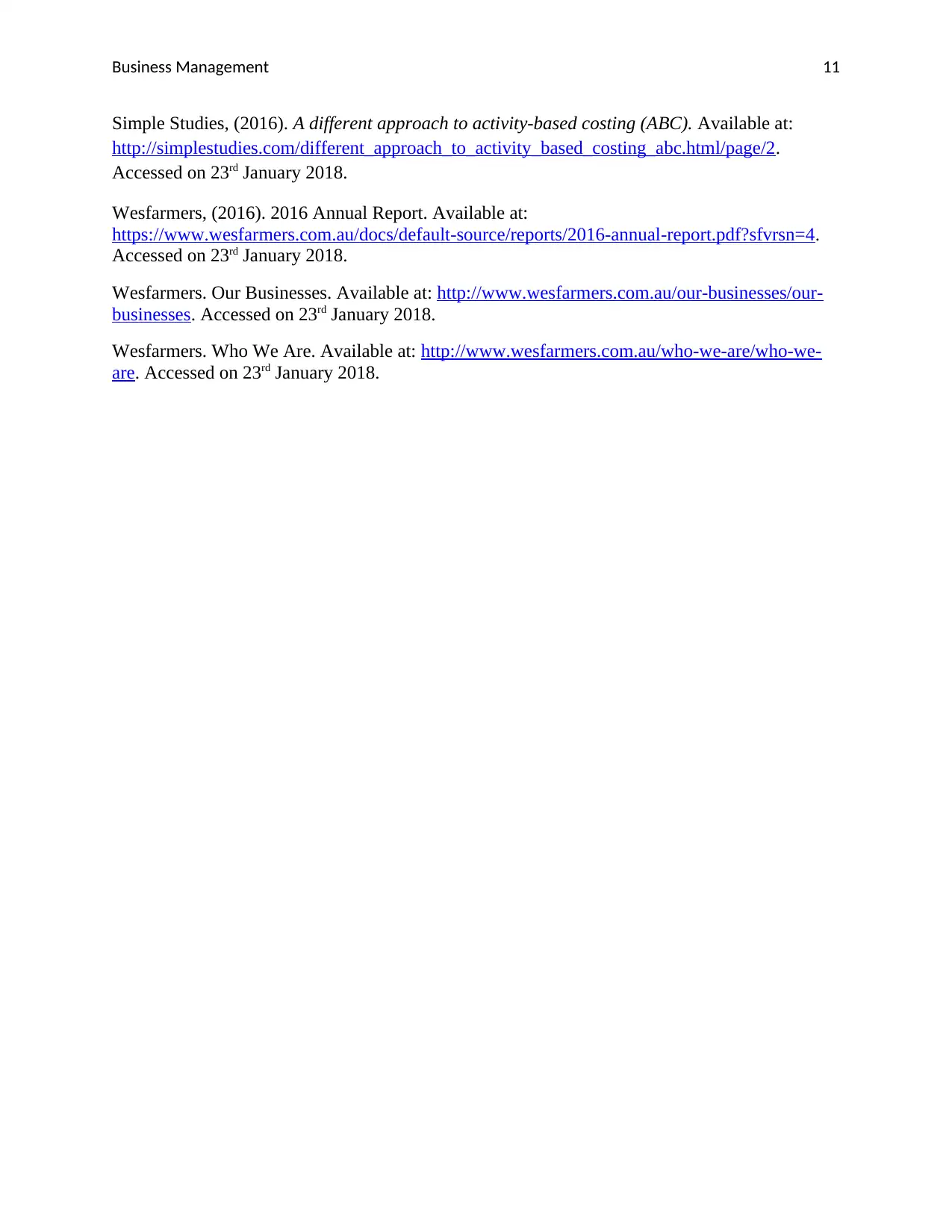
Business Management 11
Simple Studies, (2016). A different approach to activity-based costing (ABC). Available at:
http://simplestudies.com/different_approach_to_activity_based_costing_abc.html/page/2.
Accessed on 23rd January 2018.
Wesfarmers, (2016). 2016 Annual Report. Available at:
https://www.wesfarmers.com.au/docs/default-source/reports/2016-annual-report.pdf?sfvrsn=4.
Accessed on 23rd January 2018.
Wesfarmers. Our Businesses. Available at: http://www.wesfarmers.com.au/our-businesses/our-
businesses. Accessed on 23rd January 2018.
Wesfarmers. Who We Are. Available at: http://www.wesfarmers.com.au/who-we-are/who-we-
are. Accessed on 23rd January 2018.
Simple Studies, (2016). A different approach to activity-based costing (ABC). Available at:
http://simplestudies.com/different_approach_to_activity_based_costing_abc.html/page/2.
Accessed on 23rd January 2018.
Wesfarmers, (2016). 2016 Annual Report. Available at:
https://www.wesfarmers.com.au/docs/default-source/reports/2016-annual-report.pdf?sfvrsn=4.
Accessed on 23rd January 2018.
Wesfarmers. Our Businesses. Available at: http://www.wesfarmers.com.au/our-businesses/our-
businesses. Accessed on 23rd January 2018.
Wesfarmers. Who We Are. Available at: http://www.wesfarmers.com.au/who-we-are/who-we-
are. Accessed on 23rd January 2018.
1 out of 11
Related Documents
Your All-in-One AI-Powered Toolkit for Academic Success.
+13062052269
info@desklib.com
Available 24*7 on WhatsApp / Email
![[object Object]](/_next/static/media/star-bottom.7253800d.svg)
Unlock your academic potential
Copyright © 2020–2025 A2Z Services. All Rights Reserved. Developed and managed by ZUCOL.





